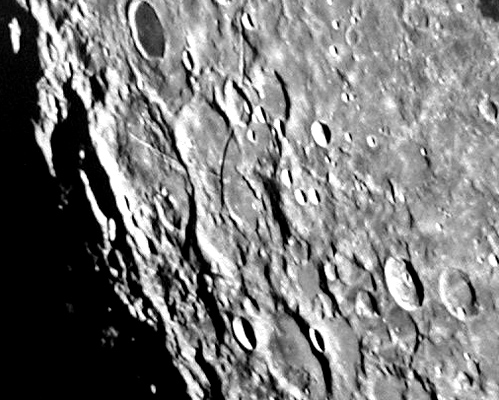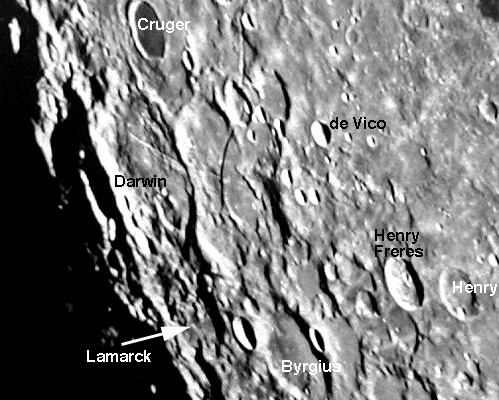Difference between revisions of "February 12, 2004"
| Line 39: | Line 39: | ||
[http://james.as.arizona.edu/~psmith/61inch/ Catalina 61"]<br> | [http://james.as.arizona.edu/~psmith/61inch/ Catalina 61"]<br> | ||
[http://www.lpi.usra.edu/research/lunar_orbiter/bin/rslt_nam.html?darwin%7C0 Lunar Orbiter IV images]</p> | [http://www.lpi.usra.edu/research/lunar_orbiter/bin/rslt_nam.html?darwin%7C0 Lunar Orbiter IV images]</p> | ||
| − | <p | + | <p><b>Yesterday's LPOD:</b> [[February 11, 2004|I drew a map so I get to add names]] </p> |
| + | <p><b>Tomorrow's LPOD:</b> [[February 13, 2004|Copernicus in Color]] </p> | ||
</td></tr> | </td></tr> | ||
</table> | </table> | ||
Revision as of 12:43, 1 February 2015
Happy Birthday, Darwin
Image Credit: Consolidated Lunar Atlas, Sheet F24 |
|
Happy Birthday, Darwin! Charles Darwin, who ranks with Newton and Einstein as one of the world's greatest scientists, was born on this date 195 years ago at Shrewsbury, England. Unlike Darwin's ideas, which remain robust, the lunar crater Darwin has seen better days. Darwin is the left of center crater cut by a diagonal rille and containing an off-center coarse dome. Although the 130 km wide crater is battered, it is easy to find near the western limb, being just south of the dark, mare-floored crater Cruger. Ironically, the crater Darwin was instantaneously aged by the formation of the Orientale basin, just over the limb. Lunar Orbiter IV images show that this entire region is mantled in deep and contorted, ground-hugging ejecta from the Orientale impact. The roughness visible in the upper right interior of Darwin is crumpled surface-flow ejecta that was decelerated by collision with Darwin's east wall. Lamarck, the crater south of Darwin, is also full of confused masses of ejecta. The visible rille in Darwin crosses it's east rim and makes an X where crossing a more northerly trending rille in the adjacent unnamed crater. The dome inside Darwin is large and rough-textured; it is also one of the few domes not on mare material. Finally, note the large crater at the bottom center. This is Byrgius, with nearly twin craters cutting its east and west rims. And on the floor of Byrgius - is that a smaller, flatter, pitted dome? Click the image above to see an image with crater names. Technical Details: Related Links: Yesterday's LPOD: I drew a map so I get to add names Tomorrow's LPOD: Copernicus in Color |
|
Author & Editor: |
COMMENTS?
Register, and click on the Discussion tab at the top of the page.
Contributions to http://www2.lpod.org/ are licensed under a Creative Commons Attribution No-Derivative-Works Non-Commercial 3.0 License. 





